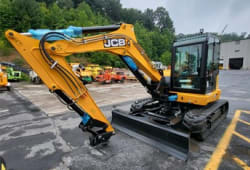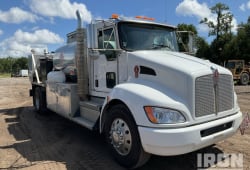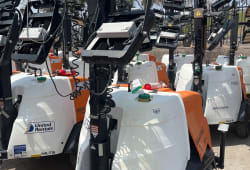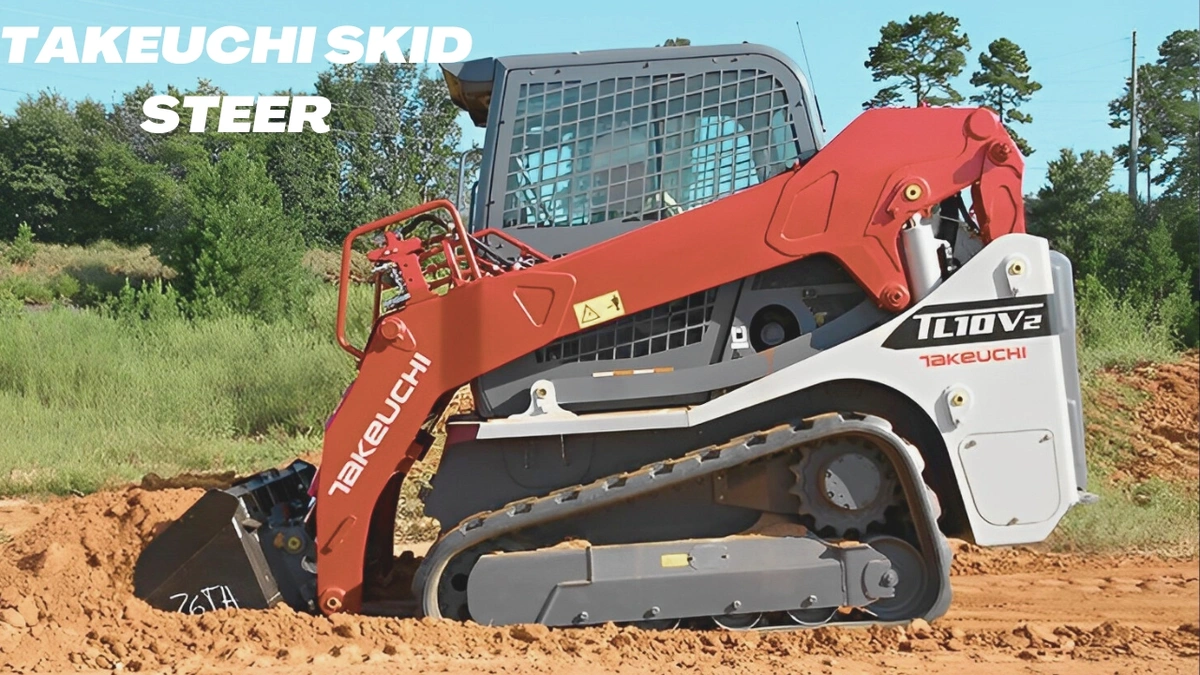Maximizing Efficiency with a Case Skid Steer
10 Min read
)
June 30, 2023
When it comes to construction and landscaping projects, time is essential. The faster you can get the job done, the more time you have to take on additional work. This is where a Case skid steer can revolutionize your workflow. Not only does this powerful machine boost productivity, but it also reduces manual labor costs, making it a wise investment for any company. In this article, we'll explore the best practices for maximizing efficiency with a Case skid steer.
Understanding the Basics of a Case Skid Steer Loader
Skid steers are versatile machines that can be used for a variety of tasks, from landscaping and construction to agriculture and mining. Among the most popular brands of skid steers is the Case skid steers, which offer a range of models with different features and specifications to suit various needs. Whether you're a seasoned operator or a novice, it's essential to understand the basics of a Case skid steer to make the most of this powerful machine.
The Main Components and Functions of a Case Skid Steer
A Case skid steer comprises four main components: the cabin, engine, hydraulic system, and undercarriage. The cabin is where the operator sits and controls the machine electro-hydraulic controls, while the engine powers the hydraulic system. The hydraulic system, in turn, enables the skid steer to move on its tracks or wheels and operate various attachments with ease. The undercarriage, which includes the tracks or wheels, supports the weight of the machine and provides stability.
The cabin of a Case skid steer typically features adjustable seats and armrests, joystick controls, and advanced instrument panels with hour meters, fuel gauges, and error indicators. The operator can use the joystick controls to operate the hydraulic system and attachments, while the instrument panels provide real-time information on the machine's performance. Meanwhile, the engine could be either diesel or gas-powered, with varying horsepower and torque ratings. The hydraulic system comprises a hydraulic pump, cylinders, valves, and hoses that work together to lift, tilt, and rotate the attachments.
The Types of Case Skid Steers
The case offers several models of skid steers, each with unique features and specifications to suit different jobs. For example, Case SV240B is ideal for heavy-duty tasks, while Case TR270 is ideal for landscaping and construction projects. Other models include Case SR210, SR240, and SV280. It's essential to choose a skid steer that matches your job requirements to maximize efficiency and safety.
Safety Features and Precautions
While skid steers are incredibly versatile, they can also be dangerous without proper precautions. That's why Case incorporates various safety features into its skid steer designs, including a backup camera, interlock systems, backup alarms, split screen display, and safety harnesses. The interlock system prevents the operator from starting the engine or operating the machine unless they are seated in the cabin and have fastened their seatbelt. The backup alarm alerts other workers in the area when the machine data is in reverse, while the safety harness keeps the skid steer loaders and operator secure in case of a rollover or other accident.
Operators should also receive comprehensive training on the machine's controls, safety protocols, and emergency procedures. This training should cover how to operate the skid steer loaders machine safely, how to attach and detach various attachments, how to perform routine maintenance, and what to do in case of an emergency. By following these safety precautions and understanding the basics of a Case and skid steer loader, operators can maximize efficiency and productivity while minimizing the risk of accidents and injuries.
Proper Operation for Increased Efficiency
Now that we know the basics of a Case skid steer, let's explore the best practices for operating a skid steer loader using it efficiently.
Operating a skid steer can be a challenging task, but with the right techniques and knowledge of skid steers, it can be done efficiently. Skid steers are versatile machines that can handle a wide range of tasks, from digging and grading to hauling and lifting. With the proper operation of skid steers, you can increase your productivity and complete your job in less time.
Starting and Stopping Procedures
Before starting the engine, perform a thorough walk-around inspection to check for leaks, damage, or loose parts. Look for any signs of wear and tear, such as worn-out tires or damaged hydraulic lines. Once you enter the cabin, fasten your safety harness, and adjust the seat and armrests to your liking.
Starting the engine is easy, but it is essential to follow the correct procedures. Depending on the model, you may need to turn the key or press the engine start button. Always make sure that the skid steer loader is neutral before starting the engine. Once the engine is running, check the gauges and indicators to ensure everything is working correctly.
To stop the engine, move the ignition switch to the off position. Always ensure the skid steer is entirely stopped before exiting the cabin. Never jump out of the cabin while the skid steer is still moving.
Maneuvering Techniques
One of the greatest advantages of a skid steer is its ability to turn within its tracks or wheels, making it highly maneuverable, even in tight spaces. To turn left or right, move the joystick lever in the corresponding direction, and to pivot in place, push both joysticks in opposite directions.
It is essential to practice safe maneuvering techniques when operating a skid steer. Always keep your hands and feet away from the attachment and the machine's moving parts. Be aware of your surroundings and avoid obstacles that could damage the machine or cause an accident.
Optimal Speeds and Controls
Knowing the optimal speed and control settings for your skid steer and attachment can significantly increase your efficiency. For instance, higher speeds are ideal for transporting materials, while slower speeds provide more control and better precision for digging or leveling. Experiment with the controls to find the ideal or more control settings for your job.
It is also essential to maintain a safe speed when operating a skid steer. Avoid sudden movements or jerky motions, which can cause the machine to tip over or lose control. Always keep a firm grip on the joystick and maintain a steady pace.
By following these best practices, you can operate your skid steer safely and efficiently, ensuring that your job is completed on time and within budget.
Selecting the Right Attachments
One of the main benefits of a skid steer loader is its versatility in accepting various attachments that can perform a wide range of tasks. Choosing the right attachment for the job is crucial to maximizing efficiency. Let's take a look at some common Case skid steer attachments and their uses.
Common Case Skid Steer Attachments
Bucket: Ideal for lifting and carrying loose materials such as gravel, sand, or debris.
Forks: Ideal for lifting and transporting pallets or other heavy objects.
Trencher: Ideal for digging trenches for pipelines or electrical cables.
Auger: Ideal for drilling holes for fence posts or tree planting.
Grapple: Ideal for lifting and transporting large, bulky objects such as tree trunks or boulders.
Case skid steer loaders are an essential piece of equipment for any construction site or farm. They are versatile and can handle a wide range of tasks, from lifting heavy objects to digging trenches. However, the key to getting the most out of your case skid steer loaders is selecting the right attachment for the job.
One of the most common attachments for a skid or steer loader is a bucket. Buckets come in many sizes and are ideal for lifting and carrying loose materials such as gravel, sand, or debris. They are perfect for cleaning up a construction site or farm, and can also be used for landscaping tasks such as moving soil or mulch.
If you need to lift and transport pallets or other heavy objects, forks are the ideal attachment. They are easy to attach and can handle large loads, making them perfect for construction sites or warehouses. Forks are also useful for stacking hay bales or moving other farm equipment.
If you need to dig trenches for pipelines or electrical cables, a trencher attachment is the way to go. Trenchers come in many sizes and can dig trenches up to several feet deep. They are perfect for construction sites or farms that require extensive digging.
For drilling holes for fence posts or tree planting, an auger attachment is the best choice. Augers come in many sizes and can drill holes up to several feet deep. They are perfect for fencing a farm or planting trees in a large area.
If you need to lift and transport large, bulky objects such as tree trunks or boulders, a grapple attachment is the way to go. Grapples come in many sizes and can handle large loads, making them perfect for construction sites or farms that require heavy lifting.
Matching Attachments to Job Requirements
When selecting an attachment, consider the job you'll be performing and the material you'll be handling. For example, a bucket attachment with a larger capacity is ideal for bulk material handling, while a narrower trencher is more suitable for precision digging. It's important to choose the right attachment for the job to maximize efficiency and get the job done quickly.
Attachment Maintenance and Storage
To maximize the lifespan of your attachments and ensure optimal performance, regular maintenance, and storage are essential. Always clean them thoroughly after use, inspect them for damage or wear, and replace any worn-out parts. Store them in a clean, dry, and secure area to prevent rust or damage. With proper maintenance and storage, your attachments will last for many years and provide reliable best in class performance on the job.
Routine Maintenance for Optimal Performance
Proper maintenance of your Case skid steer is essential to ensure it runs smoothly and efficiently. Here are some essential maintenance checks you should perform regularly.
Daily Inspection Checklist
Before using the skid steer, perform a quick daily inspection of the case skid steers to check for any visible damage, leaks, or worn parts. This checklist should include items such as tires or tracks, hydraulic hoses, belts, and filters.
Fluids and Filters
The skid steer's hydraulic system relies on hydraulic fluid to function correctly. Check and replace the hydraulic fluid regularly, as well as the filters that prevent contaminants from entering the system.
Tire and Track Maintenance
The skid steer's tires or tracks are essential for its mobility and stability. Regularly check the tire pressure, and replace any damaged or worn-out tires. If your skid steer uses tracks, inspect them for damage, tension, and alignment.
Conclusion
A Case skid steer can undoubtedly help maximize your operational efficiency and productivity in your construction or landscaping business. However, to make the most of this versatile machine, you need to understand its components and functions, choose the right attachments, and perform routine maintenance. By implementing the tips and best practices in this article, you can ensure optimal operational performance from your Case skid steer and accomplish projects faster and more efficiently.

Caleb Woods is an experienced content specialist and an editor at Boom & Bucket, blending his journalism background with expertise in the heavy equipment industry. He delivers engaging, informative content to help professionals stay informed and make smarter decisions in the machinery market.














